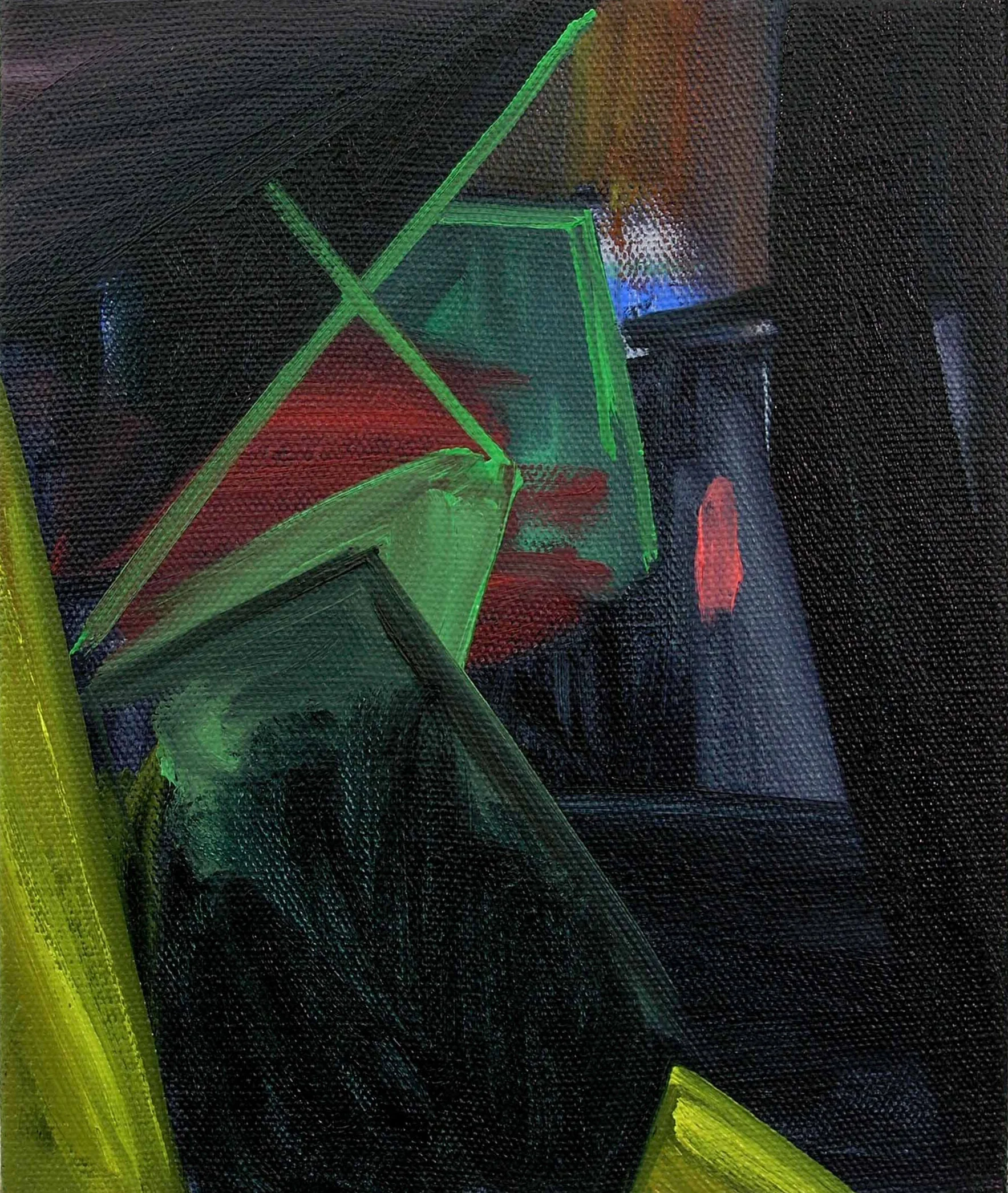The Vandal, 2007, oil on linen, 84x74”
Black Painting No. 1, 2007, oil on linen, 76x45.5”
Black Painting No. 2, 2007, oil on linen, 68x43”
Black Painting No. 3, 2007, oil on linen, 75x53”
Black Painting No. 4, 2007, oil on linen, 98x70”
Black Painting No. 5, 2008, oil on linen, 108x90”
Column, 2007, oil on linen, 75x53”
Black Painting No. 6, 2008, oil on linen, 75x53”
Black Painting No. 7, 2008, oil on linen, 75x53”
Black Painting No. 8, 2008, oil on linen, 68x43”
Study for Black Painting No. 1, 2007, oil on linen, 76x45.5”
Le Cabanon, 2007, oil on linen, 12x9"
Study For Black Painting No. 7, 2008, oil on linen, 15x11"
Study for The Vandal, 2007, oil on linen, 17x15"
Farewell To Human Scale, 2007, oil on linen, 12x9"
Study for Black Painting No. 3, 2007, oil on linen, 12x10”
Modified Column, 2007, oil on linen, 17x15”
Study for Black Painting No. 2, 2007, oil on linen, 20x16”
E1027 Table, 2007, oil on linen, 68x50”
Screen, 2007, oil on linen, 68x108”
Installation View - Farewell To Human Scale, PRAZ-DELAVALLADE PARIS, 1 December 2007 – 18 January 2008
Installation View - Farewell To Human Scale, PRAZ-DELAVALLADE PARIS, 1 December 2007 – 18 January 2008
Installation View - Farewell To Human Scale, PRAZ-DELAVALLADE PARIS, 1 December 2007 – 18 January 2008
Installation View - Farewell To Human Scale, PRAZ-DELAVALLADE PARIS, 1 December 2007 – 18 January 2008
Installation View - Farewell To Human Scale, PRAZ-DELAVALLADE PARIS, 1 December 2007 – 18 January 2008
Installation View - Farewell To Human Scale, PRAZ-DELAVALLADE BERLIN, 1 – 29 March 2008
Installation View - Farewell To Human Scale, PRAZ-DELAVALLADE BERLIN, 1 – 29 March 2008
Installation View - Farewell To Human Scale, PRAZ-DELAVALLADE BERLIN, 1 – 29 March 2008
“I admit the mural not to enhance the wall, but on the contrary, as a means to violently destroy the wall, to remove from it all sense of stability, weight, etc.” (Le Corbusier)
«This quote captures the essence of what I am exploring in these paintings. I like the idea of using painting as a means of destroying architecture, and removing its sense of stability. I also like the contradiction of an architect who desires to “violently destroy the wall.”
Painting is not bound to laws of physics like a building, it is capable of creating new spaces that architecture cannot -- spaces that exist through nothing but an arrangement of gestures and paint. Like the varied stains and brush marks in my paintings, these forms serve to both create representations of objects and spaces and call them into question.
The large painting of the living room of Eileen Gray’s E.1027 house serves as a “key” or legend to the other paintings. It depicts a mural in the living room long after Le Corbusier had painted it. The house is in a bleak state of ruin with a monstrous Picassoid figure painted on the wall. The harsh contrast within the painting appears as though it were documented through flash photography as in a crime scene or some kind of strange history painting. I like the potential confusion of the Le Corbusier mural for a Picasso painting. It represents a crisis of authenticity. It confuses authorship and history and relates also to the ambiguous attribution of Eileen Gray’s house.
The “black paintings” were envisioned as the fantastical final visions of Le Corbusier who died in 1965 of a heart attack while swimming in front E.1027 and “Le Cabanon.” I am fascinated with the depiction of light in paintings, in a purely artificial sense, light that seems to be produced by the painting rather than projected upon it.
Using colors and geometries pulled from the interior design of Le Cabanon, as well as modified forms from the murals painted on the E.1027, the paintings have a palette of reds, greens, yellows and blacks. Glowing colored geometric forms and sweeping gestures emerge from an inky black abyss as if the forms were transparent colored gels backlit by an artificial light source. The geometries, colors and forms repeat and are reconfigured in separate paintings, confusing representation and abstraction through a representation of abstract forms. The gestural brushwork undulates and mixes together, creating violently shifting architectonic planes of color, resulting in dark atmospheric spaces from which light seems to be projected. In effect, these paintings are like dying while swimming towards a neon sign.>>
This exhibition was inspired by Brett Cody Rogers’ trip to Roquebrun-Cap-Martin in 2005 where he discovered Eileen Gray and Jean Badovici's house « E.1027 » in an appalling state of disrepair.
Built in 1928, « E.1027 » is the major realization of Eileen Gray and embodies her very personal conception of modernist architecture. It was also the heart of a very complex relationship Le Corbusier had with this house, in front of which he died of a heart attack while swimming in the Baie Des Anges.
This confused link between admiration and desire finally lead Le Corbusier to intrusively appropriate this place for himself. First, he painted a suite of eight murals without Eileen Gray’s permission. She regarded the murals as an act of rape, violating the spirit of her house. Later he built his famous « Le Cabanon » overlooking the house. With the publication of photographs of the murals by Le Corbusier, mentioning the house, but omitting Gray’s name, her authorship was offended another time.
Eileen Gray, 2007, graphite on Sennelier paper, 12.5x12.5"
Le Corbusier, 2007, graphite on Sennelier paper, 12.5x12.5"
Sketch for Screen, 2007, graphite on Sennelier paper, 12.5x12.5"
Reggatta in Baie Des Anges, 2007, graphite on Sennelier paper, 12.5x12.5"
Sketch for Farewell to Human Scale, 2007, graphite on Sennelier paper, 12.5x12.5"
































